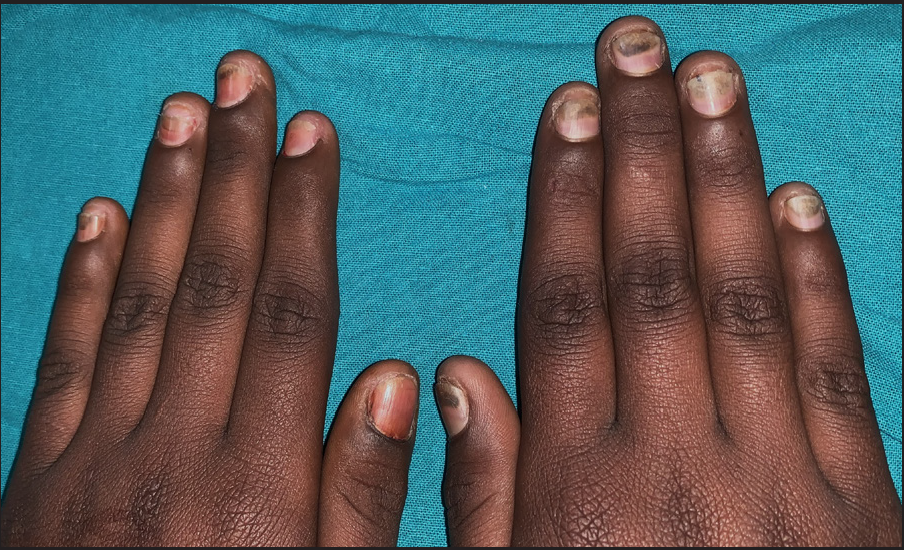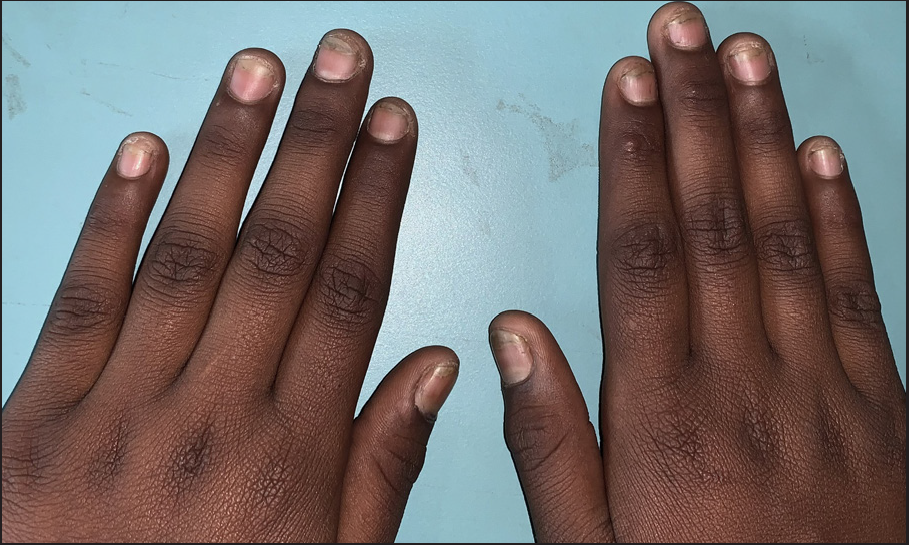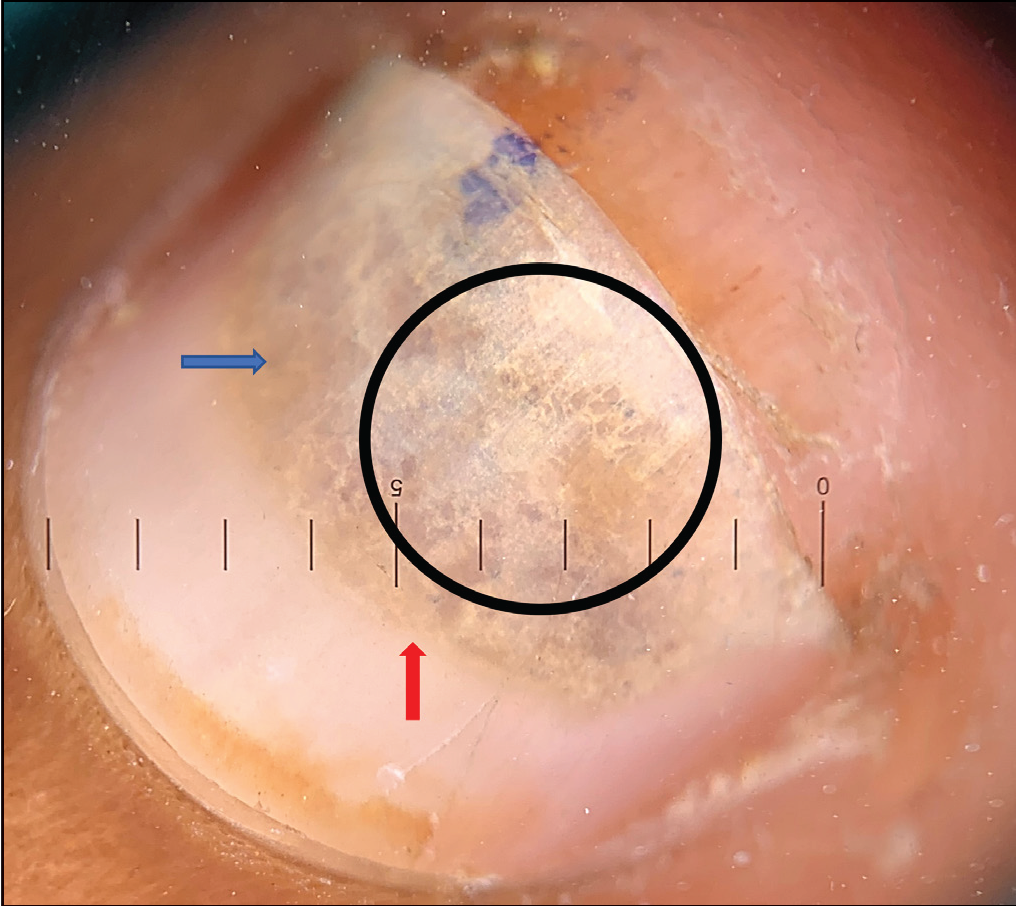Translate this page into:
Doxycycline-induced photo-onycholysis in a child: Case report and brief review
Corresponding author: Dr. Arpita Nibedita Rout, Department of Dermatology, All India Institute of Medical Sciences Bhubaneswar, Gopalpur Po Patapur Via Banki, Cuttack, Indiaarpitanrout1988@gmail.com
-
Received: ,
Accepted: ,
How to cite this article: Roy K, Asati DP, Rout AN, Doxycycline-induced photo-onycholysis in a child: Case report and brief review. Indian J Dermatol Venereol Leprol. 2024;90:494-6. doi: 10.25259/IJDVL_508_2022
Dear Editor,
Doxycycline, a tetracycline antibiotic, is used for its macrofilaricidal action in filariasis. It is an infrequent cause of drug-induced phototoxic reaction. We report doxycycline-induced photo-onycholysis in a child with lymphatic filariasis along with onychoscopic findings and also a brief review of similar cases.
A 11-year-old girl presented with symmetric, painless, moon-shaped detachment of all distal fingernail plates, sparing the covered toenails for 2 weeks. She was a diagnosed filariasis with chronic lymphedema and was on oral diethylcarbamazine therapy for a year and doxycycline 100 mg daily for the past 4 weeks. She had a history of prolonged exposure to sunlight during the winter months. There was no history of any other drug intake. On examination, distal central moon-shaped onycholysis was noted involving all fingernails with a sharp yellow-brown proximal border [Figure 1a]. Overlying red–pink exogenous pigmentation was noted over the nail plate on the left hand, not clearing on scrubbing with 70% alcohol. Dermoscopic examination revealed yellow–brown background with white honeycombed pattern overlying the nail plate with a well-defined proximal margin [Figure 2]. No splinter haemorrhage, red dots or well-defined red-brown areas were noted. A negative potassium hydroxide (10%) mount of the nail clipping ruled out onychomycosis. Other routine investigations and thyroid profile were normal. She was advised to stop doxycycline, limit daily sun exposure and trim detached distal nail plate. Partial resolution without recurrence was seen at 3 months [Figure 1b].

- Moon shaped distal onycholysis with sharp proximal margin and subungual debris.

- Partial improvement 3 months post cessation of therapy.

- White honeycombing (black circle) with background yellow brown areas (blue arrow) and sharp proximal yellow border (red arrow).
Doxycycline-induced photo-onycholysis is an uncommon, benign event following prolonged intense sun exposure. Phototoxicity following doxycycline can occur immediately or several weeks after cessation of the drug. Exposure to UVB followed by UVA1 and visible light spectrum leads to generation of free radicals mediating DNA damage and cytotoxicity.1
The selective transmission of ultraviolet rays through the convex nail plate results in painful, half-moon-shaped detachment due to concave shape of the cuticle, appearing white due to the separation of the nail plate from the vascular nail bed.1 Blue–black discolouration due to subungual dirt accumulation and brown discolouration following subungual haemorrhage have been noted. Its occurrence with photo-induced skin rash and nail discolouration comprises the segals triad.1
Baran et al. described three reaction patterns. Type 1, (most common pattern) in doxycycline-induced cases with characteristic half-moon shape with well demarcated pigmented proximal border in multiple fingers, Type 2, single digit with a prominent proximal circular notch, and Type 3, subungual haemorrhages in multiple fingers.1
We reviewed the literature for a total of 15 such cases, whose demographic and therapeutic details are mentioned in Table 1.1–4 Majority of the patients were on treatment for acne vulgaris, malaria prophylaxis and lyme disease.2,3 Phototoxic reactions were common, seen in 12 cases (80%) with higher doses of doxycycline (≥200 mg), which was similar to the findings of Baran et al.1 However, Pazzaglia et al. have reported a pediatric case developing photo-onycholysis following intake of doxycycline at dose as low as 20 mg, emphasizing the need for photoprotection at lower doses. Full recovery (3) No recovery (2) Partial recovery (2) BD: Twice a day, NM: Not mentioned, OD: Once a day, NA: Not applicable, DEC: Diethylcarbamazine, LTFU: Lost to follow up
Author, year
Study type (n = patients)
Age (years)
Dose
Time to onset
Type of onycholysis
Concomitant medication
Recovery
Our case, 2022
Case report (1)
11
l00 mg BD
3 weeks
I
Diethylcarbamazine (DEC) × 2 months
Partial recovery at 1 month
Baran et al.1
Case report (1)
10
200 mg
Days
NM
NA
NM
Lareb2
Case series (12)
8–71
100–500 mg
1–12 weeks
NM
Citalopram
Pazzaglia et al.3
Case report (1)
13
20 mg OD
1 week
I
None
Fully recovery in 3 months
Elmas et al.4
Case report (1)
16
200 mg BD
NM
I
None
LTFU
As three patients (20%) who developed photo-onycholysis were under 8 years of age, we suggest that people in this age group to take adequate photoprotective measures while using the drug. The geographical location, season, patient behaviour, time of the day (solar zenith angle ≤ 45) and lighter skin types photo react more often than type IV (our case) or III.1,4 Higher UV index (UVI) mandates strict photoprotection behaviour of the resident population with regulation of time of exposure to minimise adverse events.5 Summer flare (54.5%) and beach visits were often noted.
Elmas et al. observed bluish black discolouration, brown dots and proximal brown discolouration with sharp linear edges on dermoscopy.4 We report a novel dermoscopic pattern of ‘white honeycombing’ overlying nail plate with a well-defined proximal yellow–brown margin. A unique spiderweb pattern similar to our findings was reported by Chamli et al., however our case shows a coarser pattern than the former.6
It is a benign, spontaneously resolving disease with few cases of permanent nail dystrophy.2 Recurrence can occur if photoprotective measures are not followed with drug use.
Avoidance of sunlight is encouraged. Nail varnish is an added protective measure in females. Awareness of such presentations avoids unnecessary worry and investigations in cases with multiple nail haemorrhages simulating septic thrombi from endocarditis. The diagnostic importance of honeycomb pattern on dermoscopy should be explored in future.
Declaration of patient consent
Patient’s consent not required as the patient identity is not disclosed or compromised.
Financial support and sponsorship
Nil.
Conflicts of interest
There are no conflicts of interest.
References
- Drug-induced photo-onycholysis. Three subtypes identified in a study of 15 cases. J Am Acad Dermatol. 1987;17:1012-16.
- [CrossRef] [PubMed] [Google Scholar]
- Doxycycline and photo-onycholysis—An update. https://databankws.lareb.nl/Downloads/KWB_2013_2_doxycycline_photo_onycholysis_WEB.pdf
- Photo-onycholysis caused by an unusual beach game activity: A pediatric case of a side effect caused by doxycycline. Pediatr Dermatol. 2014;31:26-7.
- [CrossRef] [PubMed] [Google Scholar]
- A Case of Doxycyclin-induced photo-onycholysis with dermoscopic features. Balkan Med J. 2020;37:113.
- [CrossRef] [PubMed] [Google Scholar]
- The shadow rule, the UV index, and the 5S steps in the tropics. Health Phys. 2020;119:358-62.
- [CrossRef] [PubMed] [Google Scholar]
- Spiderweb-like pattern: A novel dermoscopic feature in photo-onycholysis induced by doxycycline? Therapie. 2021;76:49-50.
- [CrossRef] [PubMed] [Google Scholar]






